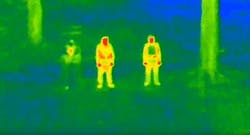Army seeks to hide soldiers on the battlefield from infrared sensors using multispectral camouflage fabrics
THE MIL & AERO BLOG – Deceiving the enemy on the battlefield is as old as the ancient world and the Trojan Horse. Among the most common modes of deception today is camouflage, which makes it difficult to see infantry warfighters, combat vehicles, and command posts by blending into their surroundings.
Yet for each approach to battlefield deception is a countermeasure; this cat-and-mouse game has been going on for millennia. One of the surest ways to defeat battlefield camouflage involves electro-optical sensors -- particularly longwave infrared that senses heat from the human body or vehicle engine exhaust.
To the naked eye or visible-light sensors like cameras, traditional camouflage can make people and vehicles all but invisible, yet infrared sensors go beyond the visible-light spectrum to see what's not visible to the human eye. To infrared sensors, a human looks like a hot spot against a relatively cool background; these sensors are not fooled.
So what's preventing military researchers from inventing a new kind of camouflage to hide humans from infrared sensors? Turns out, perhaps not much. The Army Natick Soldier Systems Center Soldier Protection Directorate in Natick, Mass., is reaching out to industry for new kinds of camouflage fabric to enable foot soldiers to conceal themselves from a wide variety of enemy electro-optical sensors.
The Army Contracting Command at Aberdeen Proving Ground, Md., sent out a source-sought notice in April on behalf of the Natick Soldier Systems Center for the Prototype: Reversible Signature Management Overwhite Garments project, which seeks to develop reversible camouflage-printed fabrics with infrared-mitigating properties.
The idea is that soldiers wearing clothing made from this infrared-mitigating fabric might be able to hide from infrared sensors on the battlefield in the same way that traditional camouflage uniforms hide warfighters from the human eye.
Researchers are seeking information on the capabilities and willingness of potential bidders to develop reversible multispectral camouflage fabrics that are invisible to infrared sensors in wavelengths ranging from visible light to longwave infrared.
Researchers want to develop an overgarment made from fabric that is reversible with and operational camouflage pattern on one side and snow marine pattern camouflage on the other -- except with visible through infrared camouflage properties.
This next-generation fabric could help the military make trousers, jackets, ponchos, and pack cover prototypes for spectral mitigation against battlefield EO/infrared sensor threats. The contractor or contractors chosen will apply thermal signature management onto different fabrics that are reverse camouflage printed.
Each side of the IR-camouflage fabric will have its own pattern that cannot be seen or bleed through to the other side, and provide thermal signature-mitigating properties while maintaining or improving today's snow overwhites in spectral performance, durability, weight, and drying rate.
From the winning contractor, the Army wants 15 to 20 yards of fabric samples to determine its comfort, durability, strength, water repellency, oil repellency, drying rate, and signature properties. Researchers expect the fabric prototypes will be scalable to produce several hundred yards of fabric.
The fabric will incorporate shortwave infrared (SWIR) reflectance on fabrics; as many as two functional finishes; be fire resistant; have no toxicity characteristics; shall weigh no more than four ounces per square yard; be water repellent and durable; should dry quickly; and retain spectral performance after laundering.
The Army wanted responses by 22 May 2024 emailed to Justin Murphy at [email protected] and Mary Prebensen at [email protected]. Email questions or concerns to Justin Murphy at [email protected] and Mary Prebensen at [email protected]. More information is online at https://sam.gov/opp/6d99f224828f45f39440b875568d9865/view.
About the Author
John Keller
Editor-in-Chief
John Keller is the Editor-in-Chief, Military & Aerospace Electronics Magazine--provides extensive coverage and analysis of enabling electronics and optoelectronic technologies in military, space and commercial aviation applications. John has been a member of the Military & Aerospace Electronics staff since 1989 and chief editor since 1995.
